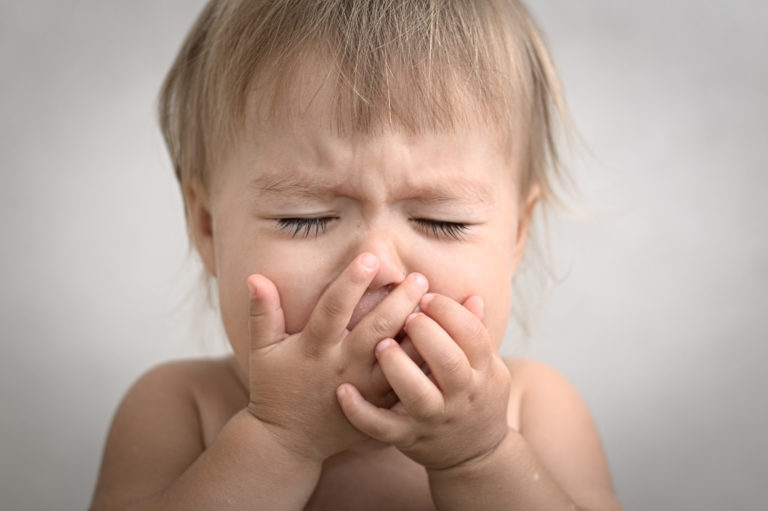
Nicole Keller, D.O.
Hello again! I just returned from maternity leave in the thick of cold and flu season. But in addition to the common cold and that nasty influenza bug, there is another illness that is roaring through the pediatric population at the moment – bronchiolitis! This is a big scary word and in my blog I’d like to help you understand what it means to us and to your kids.
Bronchiolitis is a fancy term for inflammation of the smallest parts of the lung tree (the teeny tiny little airways in the lungs). In addition to inflammation, the hallmark of this illness is large amounts of secretions – basically, your child becomes a boogery mess! It is a constant running of the nose, congestion, and mucus build up in the upper airway. This leads to stuffy noses, wet coughs, and sometimes difficulty breathing and eating. You can also have fevers on and off with this illness. Some kids will have wheezing in their lungs but this is usually from mucus plugging – not airway muscle spasm (like in asthma).
Bronchiolitis tends to have the most effect on young children – you can contract the viruses that cause bronchiolitis at any age but the clinical presentation of bronchiolitis typically is seen in kids less than one year old. Part of the reason we worry about bronchiolitis is because of this tendency for it to have the most power in our littlest patients. You see, they have the smallest of the smallest airways, so, when you clog up those airways with mucus, they have the hardest time clearing those airways to breathe. If you can’t breathe well, you can’t get oxygen where it needs to be and that’s bad. Additionally, if you can’t breathe, many times it makes it hard to eat. If you have a baby who can’t breathe well and has a hard time staying hydrated it can be a really tough road to get through this illness.
What causes this nasty bronchiolitis you might ask? One of the most common viruses associated with bronchiolitis is called RSV (respiratory syncytial virus). Other viruses (like coronavirus, metapneumovirus, parainfluenza, etc) cause bronchiolitis but RSV is the one we tend to worry about the most – although none of them are fun. The virus stays in the system for a few weeks but is the most contagious in the first days to weeks of the illness. The entire illness may actually take four to six weeks to resolve completely. That’s an eternity when you are dealing with a sick little one at home!
So what can you do for bronchiolitis – how do you get your kids through this common, yet miserable, disease? In short, supportive care. You see, bronchiolitis is caused by viruses, and viruses don’t respond to antibiotics. Viruses get better on their own with time. But, until that “time” has come when your child is finally recovering from this illness, there are some “supportive” things you can offer your child.
Supportive care options for bronchiolitis:
- Push fluids, small amounts often to maintain hydration.
- Acetaminophen (Tylenol) or ibuprofen (motrin) to help with discomfort or fevers. No motrin in kids less than six months.
- Suction the nose with nasal saline – you can use drops or a mist to apply into the nasal passages and then suction out the mucus with a bulb syringe or other suction device (such as a “NoseFrida”).
Other treatment options can sometimes include breathing treatments and even less commonly steroids, but, the AAP doesn’t recommend these on a regular basis since they really don’t help much and may just result in side effects.
Your child should be seen if they are having symptoms like this. We’ll want to check their oxygen level, hydration, and breathing status to make sure they are handling the illness appropriately. Sometimes, kids that aren’t doing well with this illness need to be hospitalized for intense supportive care that may include oxygen administration, IV fluids for hydration, and frequent deep suctioning. Bronchiolitis can result in complications rarely so we are very cautious with these children.
If your child is having trouble drinking, having trouble breathing (such as sucking in between or under the ribs), having fevers for longer than five days in a row, or other worsening symptoms, they should be seen in your pediatrician’s office or in the ER if they are in distress. If you’re not sure, call us! We can help decide with you over the phone to make sure your child gets the care they need.
In the end, bronchiolitis is a common, miserable viral illness that affects nearly everyone at some point in their life. It is mostly harmless, but, can take a lot of effort and a long time to resolve and sometimes gets worse before it gets better. Remember to have your child seen if you are worried about this illness. Please call your pediatrician’s office if you have questions or concerns about this…oh, and wash your hands to help stop the spread of illnesses like this too. Thanks for reading!

